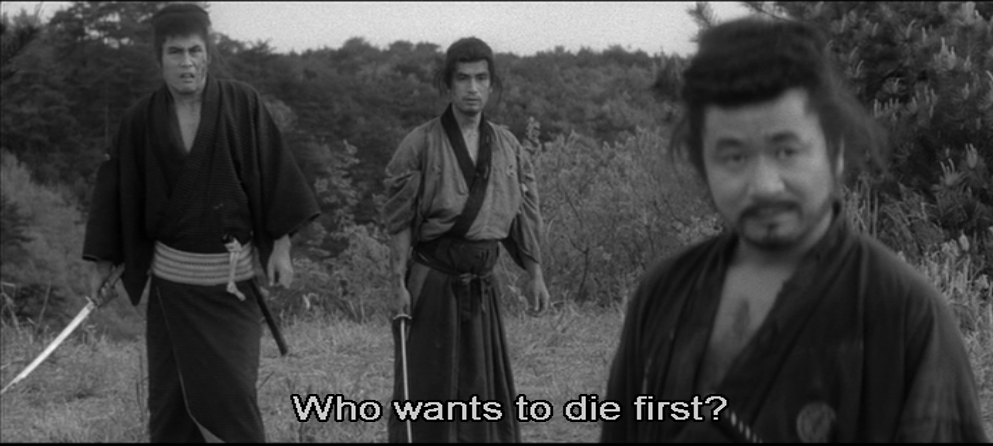Three Outlaw Samurai (1964) directed by Hideo Gosha.
Times are tough in this rural district of Japan. There’s been a succession of bad harvests, but no reduction in taxes, so the peasants are starving and broke. In desperation, several farmers have kidnapped the daughter of the local magistrate in an effort to extort him into presenting their case to the provincial lord. Three masterless samurai are also in the area, and about to be swept up into this crisis.

This was the first movie directed by Hideo Gosha, who’d previously worked in television, including directing the first season of the television series the movie is a prequel to. In that series, three ronin travel from place to place righting wrongs and protecting the weak. This film reveals how the trio gets together.
The first samurai we meet is Shiba, who finds a woman’s hairpin on the path to an old mill, investigates, and learns about the kidnapping. Once it’s clear that the farmers aren’t going to rape Aya, the magistrate’s daughter, or seriously harm her, he starts helping them out. He knows full well the magistrate isn’t going to respond well to this tactic.
The next to join is Sakura, a scruffy spear carrier that was in jail for vagrancy. He’s offered his freedom and a reward for fighting the farmers and their new samurai ally. On the way to the mill, Sakura is ambushed by one of the farmers, and kills the man. But once he hears the truth about what’s going on, Sakura switches sides. Later, he starts developing feelings for Oine, widow of the man he killed, who doesn’t know the truth. Awk-ward.
Kikyo is nominally on the magistrate’s side for much of the movie, as he’s been freeloading off that household’s food supply. He is, however, careful to avoid any of the more heinous actions requested by the magistrate. When the magistrate demonstrates straight up that he is a man without honor, Kikyo defects.
Meanwhile, the magistrate is trying to keep the news of the peasant disgruntlement as quiet as possible, no matter what dirty tricks he has to pull to ensure that. The lord is visiting this district in a few days, and if the petition disturbs the lord in any way, the magistrate is sure to lose his position.
Since this is a samurai revenge drama,while we know the three central characters are going to make it out alive somehow, don’t get too attached to anyone else.
The good: Our main trio are honorable men who try to do the right thing, even in a cynical world where doing the right thing is often fatal or a failure. They don’t always live up to their own standards, but their consciences are very much alive. Overall, everyone’s motivations and the resulting actions ring true.
There’s some excellent action sequences. I especially liked the invasion of the old mill for good fight choreography in a cramped space filled with obstacles.
Less good: Some parts of the film felt like they were shot for television rather than a movie, not using the full frame well. I am given to understand that Mr. Gosha quickly became much better at this. Sakura and Oine’s romance felt very rushed, as though it were put in solely for the sake of having a little romance.
Content notes: As expected from a samurai drama, there’s plenty of black and white blood being spilled. There’s also a couple of torture scenes. Kikyo has sex with a prostitute just off-screen.
Recommended to fans of samurai revenge drama. Sadly, it appears that the first few seasons of the TV show the movie is based on have been lost, so following up with that is not an option.

